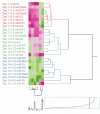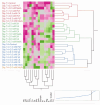Comparative Effects of Putrescine, Salicylic Acid, Citric Acid, and Methyl Jasmonate on Postharvest Quality and Storage Life of Pleurotus ostreatus
- PMID: 40313797
- PMCID: PMC12041666
- DOI: 10.1002/fsn3.70233
Comparative Effects of Putrescine, Salicylic Acid, Citric Acid, and Methyl Jasmonate on Postharvest Quality and Storage Life of Pleurotus ostreatus
Abstract
This study was carried out to determine the effects of exogenous putrescine, salicylic acid, citric acid, and methyl jasmonate treatments at different doses (0.5 mM, 1.0 mM, and 2.0 mM) after harvest on quality properties, storage period, and nutrient content in Pleurotus ostreatus mushroom species, which ranks second in terms of production in the world and deteriorates rapidly after harvest and loses its quality. A total of 13 different treatments were examined in the study, and the necessary measurements and analyses (on the 7th and 14th days) were performed on the mushrooms stored at 4°C for 14 days. As a result of the research, it was determined that the postharvest quality characteristics changed significantly depending on treatments and storage periods. The results showed that postharvest treatments significantly influenced weight loss, dry matter, protein content, color, pH, and mineral composition during storage. Compared to the control, 0.5 mM methyl jasmonate was the most effective in preserving protein content (increased by 13.56%) and calcium content (increased by approximately threefold), while 2.0 mM citric acid reduced weight loss by 7.76% and increased zinc content by 57%. Principal component analysis and cluster analysis further confirmed that citric acid and methyl jasmonate treatments were superior in maintaining postharvest quality. It was concluded that 0.5 mM methyl jasmonate, 0.5 mM, 1.0 mM, and 2.0 mM citric acid treatments can be recommended as an alternative application method to reduce postharvest quality losses of P. ostreatus.
Keywords: Pleurotus ostreatus; color properties; natural compounds; nutritional properties; storage.
© 2025 The Author(s). Food Science & Nutrition published by Wiley Periodicals LLC.
Conflict of interest statement
The authors declare no conflicts of interest.
Figures




Similar articles
-
Exogenous citric acid, salicylic acid, and putrescine treatments preserve the postharvest quality and physicochemical properties of broccoli (Brassica oleracea L. var. italica) during cold storage.Food Sci Nutr. 2023 Nov 27;12(3):1686-1705. doi: 10.1002/fsn3.3862. eCollection 2024 Mar. Food Sci Nutr. 2023. PMID: 38455170 Free PMC article.
-
Alterations in quality characteristics and bioactive compounds of blackberry fruits subjected to postharvest salicylic acid treatment during cold storage.Food Sci Nutr. 2024 Sep 24;12(11):9123-9135. doi: 10.1002/fsn3.4490. eCollection 2024 Nov. Food Sci Nutr. 2024. PMID: 39619955 Free PMC article.
-
Effects of salicylic acid and putrescine on storability, quality attributes and antioxidant activity of plum cv. 'Santa Rosa'.J Food Sci Technol. 2015 Apr;52(4):2053-62. doi: 10.1007/s13197-013-1232-3. Epub 2013 Dec 23. J Food Sci Technol. 2015. PMID: 25829585 Free PMC article.
-
Pre- and Postharvest Strategies for Pleurotus ostreatus Mushroom in a Circular Economy Approach.Foods. 2024 May 9;13(10):1464. doi: 10.3390/foods13101464. Foods. 2024. PMID: 38790763 Free PMC article. Review.
-
Effect of gamma and electron beam irradiation on the physico-chemical and nutritional properties of mushrooms: a review.Food Chem. 2012 Nov 15;135(2):641-50. doi: 10.1016/j.foodchem.2012.04.136. Epub 2012 May 2. Food Chem. 2012. PMID: 22868140 Review.
References
-
- Adebayo, E. A. , and Oloke J. K.. 2017. “Oyster Mushroom Pleurotus Species: A Natural Functional Food.” Journal of Microbiology, Biotechnology and Food Sciences 7, no. 3: 254–264.
-
- Ahvenainen, R. 1996. “New Approaches in Improving the Shelf Life of Minimally Processed Fruit and Vegetables.” Trends in Food Science & Technology 7: 179–187.
-
- Akbarirad, H. , Kazemeini S. M., and Shariaty M. A.. 2013. “Deterioration and Some of Applied Preservation Techniques for Common Mushrooms.” Journal of Microbiology, Biotechnology and Food Sciences 2, no. 6: 2398–2402.
-
- Akbulut, A. 2015. Effect of Various Doses of Salicylic Acid on the Development of Penicillium expansum on Postharvest Tomato Fruits MSc Thesis. Harran University Graduate School of Natural and Applied Sciences.
-
- Akyüz, M. , and Kırbağ S.. 2010. “Nutritive Value of Wild Edible and Cultured Mushrooms.” Turkish Journal of Biology 34, no. 1: 97–102.
LinkOut - more resources
Full Text Sources
Research Materials

